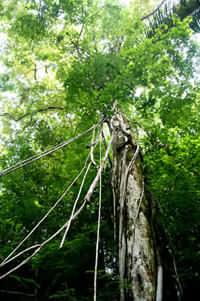|
 Biodynamic Gardening in the Tropics - Part 3 Biodynamic Gardening in the Tropics - Part 3
Soil Enrichment Elements - Mulch
Mary Lynn Perry
Of the three basic elements of soil-enrichment, manure, compost, and mulch, mulching (in MY opinion) is the MOST IMPORTANT, most beneficial, and definitely the easiest technique of all.
Just for kicks (and to prove the amazing benefits), do a test in your gardens. Choose two plants (same type) of equal age and size. Pile a generous amount of grass clippings or leafy cuttings in a mound around the base of one. The difference should be noticeable in a month or so, rain or shine (any season of the year). Mulching produces truly miraculous results!!!
At Rainsong, our mulched coconut trees started producing coconuts in less than two years after being planted from a sprouted nut. The ones that we didn't mulch hadn't even developed a trunk yet, much less produce fruit. The mulched ones (at one and a half years) already had a trunk diameter of 10 to 12 inches (25 to 30 centimeters) and the "heart" (from which the new leaves emerge) was over 6 feet (2 meters) high. The hearts of the un-mulched ones were still near ground level, with no trunk emerging yet. All the coconuts were the same species, and were all planted at the same time with the same technique (biodynamic).
Mulch protects and nourishes plants year-round. In dry season, mulch protects the root system from heat damage. It absorbs and conserves moisture (which means less watering is necessary). It nourishes the plant as it biodegrades into compost. It protects the plants from invasive weeds and vines (to some extent). It discourages insects that attack the roots or stems. In rainy season, mulching helps prevent erosion of topsoil. It protects from invasive weeds and vines. It provides vital aeration for the root system while it continues to provide nourishment to the plant through decomposition.
Mulch will biodegrade at varying speeds, depending on the materials used and the season. Re-mulching can be done on a continual basis as needed, or on a schedule that coincides with changes in seasons. At Rainsong we do broadscale mulching (we try to mulch everything!) at least twice a year: at the beginning of the rainy season, and at the beginning of the dry season. This is especially important for fruit trees. For veggie beds (raised) we use heavy mulching for weed and insect control. What few weeds that do penetrate are easily pulled up through the loose soil created by the mulch. For running vines (watermelon, cucumber, squash, etc.) large areas are heavily mulched and the seeds are planted in small hills scattered throughout the mulched area. The mulch also protects the fruit from rot as they mature.
The materials used for mulch are almost limitless: grass and weed clippings, leafy trimmings, rotting logs, cardboard, newspaper, even old clothes. We often use raw cow manure as mulch under fruit trees and favorite ornamentals. "Sheet mulching" is a favorite technique in permaculture. It requires several layers of different mulching materials (cardboard, etc.). The initial efforts required are minimal when compared to the benefits and beauty of a weed-free, nourished garden or veggie patch.
For more information on biodynamic gardening, visit Rainsong in Cabuya. Go 100 meters past SuperChicho (to the southeast), then take the lane to the right (northwest) and follow our signs. Or contact us by email. Rainsong's nursery is open to the public every Saturday and Sunday all day. We specialize in reforestation, rare and endangered native tropical hardwoods, open-air butterfly gardens, fragrant & flowering trees, and heirloom fruit trees (non-hybrids).
|


